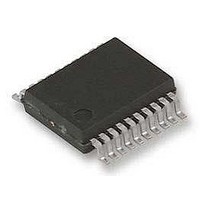ATA5744N-TKQY 19 Atmel, ATA5744N-TKQY 19 Datasheet - Page 4

ATA5744N-TKQY 19
Manufacturer Part Number
ATA5744N-TKQY 19
Description
RF Receiver RF DATA CONTROL RECEIVER
Manufacturer
Atmel
Type
Receiverr
Datasheet
1.ATA5744N-TKQY.pdf
(20 pages)
Specifications of ATA5744N-TKQY 19
Package / Case
SSO-20
Operating Frequency
449 MHz
Operating Supply Voltage
4.5 V to 5.5 V
Maximum Operating Temperature
+ 105 C
Minimum Operating Temperature
- 40 C
Mounting Style
SMD/SMT
Noise Figure
7 dB
Operating Frequency (max)
450000kHz
Operating Temperature (min)
-40C
Operating Temperature (max)
105C
Operating Temperature Classification
Industrial
Product Depth (mm)
4.4mm
Operating Supply Voltage (min)
4.5V
Operating Supply Voltage (typ)
5V
Operating Supply Voltage (max)
5.5V
Lead Free Status / RoHS Status
Lead free / RoHS Compliant
4
ATA5744
Figure 3-1.
The passive loop filter connected to pin LF is designed for a loop bandwidth of B
This value for B
the appropriate loop filter components to achieve the desired loop bandwidth
f
formula:
f
To determine f
frequency is f
is tuned by the crystal frequency f
f
MODE = 0 USA f
MODE = 1 Europe f
The relation is designed to achieve the nominal IF frequency of f
tions. For applications where f
f
f
rizes the different conditions.
The RF input either from an antenna or from a generator must be transformed to the RF input
pin LNA_IN. The input impedance of that pin is provided in the electrical parameters. The para-
sitic board inductances and capacitances also influence the input matching. The RF receiver
ATA5744 exhibits its highest sensitivity at the best signal-to-noise ratio in the LNA. Hence, noise
matching is the best choice for designing the transformation network.
A good practice when designing the network, is to start with power matching. From that starting
point, the values of the components can be varied to some extent to achieve the best sensitivity.
If a SAW is implemented into the input network a mirror frequency suppression of P
can be achieved. There are SAWs available that exhibit a notch at f = 2 MHz. These SAWs
work best for an intermediate frequency of IF = 1 MHz. The selectivity of the receiver is also
improved by using a SAW. In typical automotive applications, a SAW is used.
LO
LO
LO
RF
IF
is then dependent on the logical level at pin MODE and on f
= f
that depends on the logic level at pin mode. This is described by the following formulas:
= 433.92 MHz, MODE must be set to '1'. For other RF frequencies, f
is determined by the RF input frequency f
RF
– f
IF
IF
LO
PLL Peripherals
= 1 MHz. To achieve a good accuracy of the filter's corner frequencies, the filter
Loop
, the construction of the IF filter must be considered at this point. The nominal IF
IF
= f
IF
exhibits the best possible noise performance of the LO.
LO
= f
/314
LO
/432.92
LFGND
LFVCC
DVCC
XTO
LF
XTO
RF
= 315 MHz, MODE must be set to '0'. In the case of
. This means that there is a fixed relation between f
V
V
S
S
C9
R1
RF
and the IF frequency f
C10
C
L
C9 = 4.7 nF
C10 = 1 nF
R1 = 820
RF
.
Table 3-1 on page 5
IF
= 1 MHz for most applica-
IF
is not equal to 1 MHz.
IF
using the following
Figure 3-1
Loop
4893A–RKE–11/05
Ref
= 100 kHz.
summa-
= 40 dB
shows
IF
and















